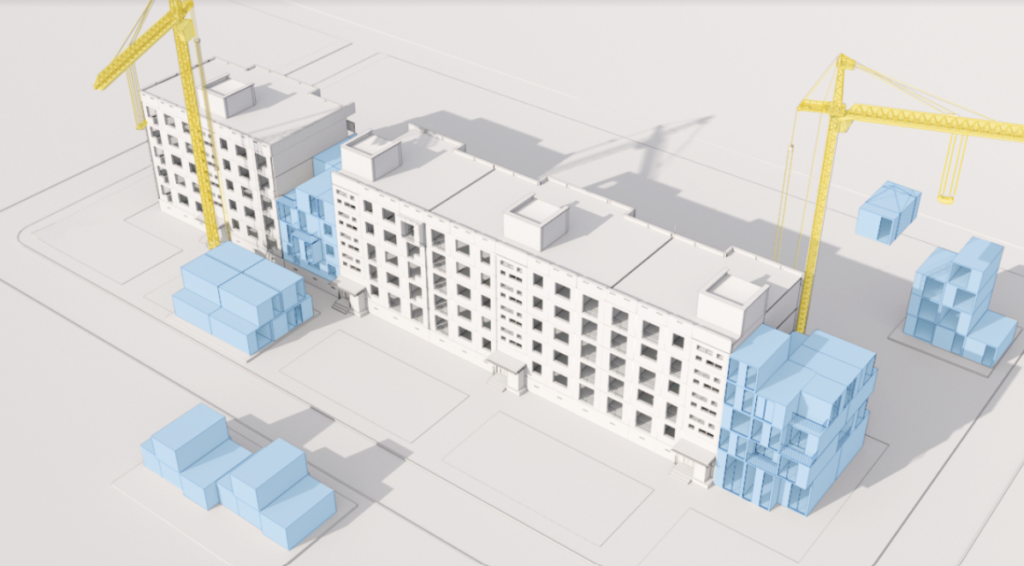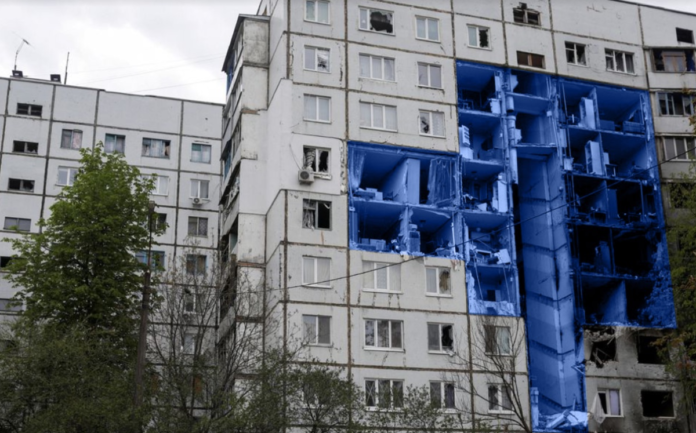Michael Lewis
Special to Ontario Construction Report
A prefabricated system of stackable building modules developed by Toronto-based WZMH Architects that fits with Soviet-era apartment construction is being adapted to potentially speed restoration of structures across Ukraine damaged or destroyed since the launch of the Russian invasion.
 “When the war started, I realized that I needed to do something,” said WZMH principal and Ukrainian-Canadian Zenon Radewych, adding that the firm’s precast modular concrete technology called Speedstac was initially designed to address housing and labour shortages in North America.
“When the war started, I realized that I needed to do something,” said WZMH principal and Ukrainian-Canadian Zenon Radewych, adding that the firm’s precast modular concrete technology called Speedstac was initially designed to address housing and labour shortages in North America.
Developed in the firm’s Sparkbird innovation lab, an R&D partnership that includes Spring Valley Corp., Stephenson Engineering, Quasar Consulting and Argentum with support from Microsoft, Speedstac also features standardized materials and dimensions similar to those of the Soviet Union-era apartments found across eastern Europe.
After WZMH hired a team of seven Ukrainian architects who had fled or were preparing to flee the war for Canada and who were able to provide first-hand knowledge of the situation on the ground “we realized that hey, wait a minute, we could actually use this solution in Ukraine,” Radewych told the CBC.
 The firm is now seeking project funding and collaborating with local partners to get the first pilot modules built and installed, with plans for module manufacturing and construction to then begin in more stable parts of the country. It says local authorities are limited in the funding they can provide but are eager to provide building approvals and permits.
The firm is now seeking project funding and collaborating with local partners to get the first pilot modules built and installed, with plans for module manufacturing and construction to then begin in more stable parts of the country. It says local authorities are limited in the funding they can provide but are eager to provide building approvals and permits.
WZMH says Ukraine officials have requested proposals that could be part of requests for project funding on how Speedstac might be used to restore specific buildings.
The firm is also working with architects, universities, and students in Ukraine to encourage Speedstac designs and sponsors paid design internships at Ukrainian universities, as well as organizing hackathons among architecture and IT students.
As war rages on, the destruction has created one of the world’s most acute housing shortages. An estimated 121,000 buildings in Ukraine have been fully or partially destroyed since the Russian invasion began in February 2022 — the equivalent of 61 million square metres of residential space.
WZMH says the Ukraine housing crisis has added to its focus on innovative technology that could facilitate reconstruction efforts. The 10-to-12 foot wide and 30-to-40-foot long Speedstac modules can be assembled in stacks or in rows and transplanted into apartment buildings to replace existing units. Once buildings are stabilized destroyed sections could be sheared away, with Speedstac modules lowered into their place with cranes and guidance software.
Using locally built concrete modules sized to the exact dimensions of the cavities in the building, new structural units would be slotted in from above. Designed as self-contained rooms with electrical and plumbing built inside their walls, the three to nine storey modules would be retrofitted to the building’s existing infrastructure.
The technology would replace portions of mid-rise and high-rise buildings damaged by fire and missile strikes without needing to demolish the buildings altogether, or to insert components into an existing poured concrete structure. Modular units would slide into the existing building and replace damaged sections with new residential units. The units would be fabricated off-site and plugged in quickly over days or weeks depending on the scope of the reconstruction, with few workers required on site.
The Speedstac design also features a so-called special connector to hold modules and existing structures together, with the modules designed to reduce the need for new finishes such as gypsum board and tiles and including a special layer that eliminates the need for bulkheads. The technology resolves acoustical and fire separation issues with high-strength concrete on all four sides of the unit, while increasing durability to cut material use, emissions, and costs.
The design’s Ukraine application has been endorsed by Ukraine and Canadian embassies and WZMH says it has secured funding for the construction of two prototype Speedstac modules in Ukraine. It aims to assess the units for factors including weight bearing capacity and connection strength as well as for mass-production potential.
WZMH is using remote scanners mounted on drones to make 3D models of buildings that are potentially compatible with Speedstac. It says its has identified apartment buildings as candidates for 3D analysis and is also relying on architects in Ukraine to collect information on prospective buildings. Ukraine could be a pilot for this technology, which could then be used to address housing shortages and disasters elsewhere in the world, Radewych said. “What’s going to come out of the Ukraine situation is a lot of great inventions that will be used for the next 30, 40, 50 years.”

